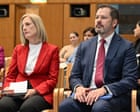
In Australia’s dynamic landscape of both governance and cultural affairs, recent developments highlight the interplay between administrative decisions and community-level impacts. At the center of these changes are significant appointments in government roles and adjustments in funding for regional art galleries, reflecting broader shifts in policy and emphasis.
In a move that has generated attention, a trade union leader has been appointed to the board of the federal government’s $15 billion National Reconstruction Fund. Glenn Thompson, who serves as the national president of the Australian Manufacturing Workers’ Union (AMWU), accepted this key role, despite the fact that he was neither shortlisted nor subjected to a standard formal “due diligence” check by private recruiters. This appointment has sparked discussions and an audit report on the establishment of the fund is underway to understand the processes behind such appointments better. These investments aim to revitalize sectors and stimulate economic growth, making governance transparency paramount.
Meanwhile, in New South Wales, regional art galleries are experiencing their own challenges amidst financial restructuring. The state’s decision to withdraw its financial support, following a significant reorganization of Create NSW, has left three out of four public art galleries in a funding crisis. Much of the public art life in cities like Wagga Wagga, Orange, Armidale, Broken Hill, and Tamworth is contingent on four-year government funding, which previously ranged between $70,000 and $200,000 annually per institution. Regional galleries serve as vital cultural hubs, often contributing to local economies and the community’s cultural enrichment. In response, peak arts bodies are urging a review of these funding decisions, emphasizing the importance of these galleries in maintaining the vibrant cultural ecology of regional Australia.
These stories underline the intricate balance between governance actions and their tangible effects on society—whether by strengthening industry capabilities or nurturing cultural wealth. As these sectors evolve, ongoing dialogue and audits ensure that transitions occur with fairness and foresight, fostering resilience and creativity within Australian communities. Changes in such domains invite reflection on the roles individuals and institutions play, encouraging collaborative approaches to policy and sustainable cultural investment.
In essence, the landscape of Australia’s governance and cultural sector is at a pivotal point. As leaders and communities navigate these developments, the emphasis on thoughtful planning and support remains crucial. Both government and cultural entities are essential threads in the fabric of the nation, each contributing uniquely to the broader narrative of growth and enrichment. Through constructive engagement and transparent processes, Australia can aspire to balance innovation and tradition, fostering a thriving environment for its populace.
Source: {link}
